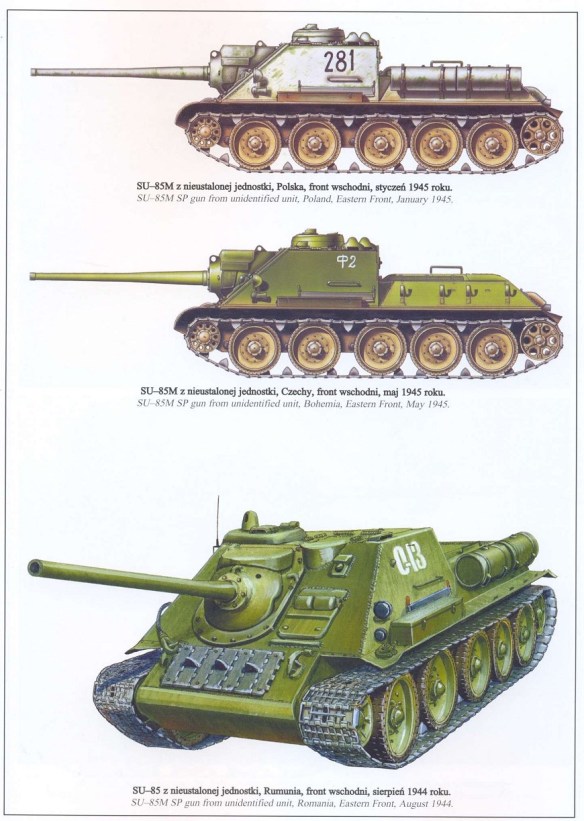SU-85
The SU-85 was designed to counter German Tiger and Panther tanks introduced in 1943 that had out-ranged the T34 with their 8.8cm (3.34in) and 7.5cm (2.95in) guns. It was based on a T34 chassis with aV-12 373kW (500bhp) engine but with a simple superstructure mounting an 85mm (3.34in) D-5S gun. It was put together as a prototype very quickly and production was underway at the Uralmashzavod and Kirov plants in mid-1943. The SU-85 was 6.58m long (21ft 7in), 2.99m (9ft 10in) wide and 2.54m (8ft 4in) high. It weighed 29,600kg (29.13 tons) and had a crew of four. The vehicle had a road speed of 48km/h (30mph) and range of 320km (200 miles). Production halted when the T-34/85, armed with the D-5S gun, entered service.
SU-100
When the T-34/85 entered service, the Uralmashzavod factory took the chassis of the SU-85 and mounted the M1944 100mm (3.9in) D-10S naval gun. With muzzle velocity of 895m/s (2936ft/s), it fired a 15.88kg (35lb) shell to a maximum range of 20,650m (22,580yd).
The SU-100, which had 34 rounds stowed on board, was more than capable of destroying the heaviest German tanks. Its all-up weight was 32,515kg (32 tons); it was 5.92m (19ft 5in) long, 3m (9ft 10in) wide and 2.54m (8ft 4in) high. The V-12 diesel gave 373kW (500bhp) and a road speed of 56km/h (35mph) and a range of 300km (186 miles). Armour protection for the hull front was 75mm (3in) and for the gun mantlet 110mm (4.3in).
SU-122
In April 1942 the Central Artillery Directorate (GAU) instructed several teams to begin work on a medium mechanized self-propelled vehicle capable of mounting the powerful 122mm (4.8in) gun. The work of the Uralsky Heavy Machine Tool Factory (UZTM) and Zavod Nr 592 was overseen by a special team from the Commissariat for Tank Production (NKTP).
UZTM based its U-35 (subsequently known as the SU-122) vehicle on the chassis and hull of the T-34, placing the M-30 122mm (4.8in) gun in a fully armoured casemate with 45mm (1.77in) frontal armour. The increased size of the crew compartment, in comparison to a turreted vehicle, allowed a crew of five (commander, gunner, driver, and two loaders) to operate the large gun with relative ease. To increase production and also to keep costs low, the engine and transmission of the T-34 were retained.
With an overall weight just over 30.5 tonnes (30 tons), the SU-122 had a road speed of 55km/h (34mph) and with added fuel tanks, a range of 300km (186 miles), making it more than capable of keeping up with rapidly advancing Soviet tank forces. Production of the SU-122 began in late December 1942 after receiving approval from GKO.
Although the SU-122 was capable of engaging enemy armour, the heavy weight of its shell reduced the muzzle velocity, making it a poor antitank weapon. Attempts to improve its firepower with the BP-460A HEAT (High Explosive Anti-Tank) round proved less successful than hoped and, like most Soviet self-propelled guns, its primary role was direct fire support of infantry against enemy strongpoints. Even so, at short range the SU-122, with its low profile and large gun, was capable of dealing with heavy German armour, although results could be mixed.
In August 1943 the. Red Army followed up its victory at Kursk with a powerful drive on the city of Kharkov in Operation Polkovodets Rumnyantsev. Attempting to halt the Soviet thrust, the German High Command mounted a series of counterattacks against the centre and eastern flank of Soviet tank forces. The Panzergrenadier Division Grossdeutschland spearheaded the eastern attack against Twenty-Seventh Army and the flank of the First Tank Army.
As the Front Commander General N. F. Vatutin threw in reserves, initially to stabilize the front and then counterattack, a vicious melee erupted, lasting from 18 to 21 August. At one point on 21 August, Tiger tanks of the Grossdeutschland, 3rd Panzer Regiment were roughly handled by SU-122 guns of III Guards Tank Corps. One Tiger of the 10th Company suffered six hits to its turret, but none of the rounds penetrated; instead they either dented, or chipped small pieces off, the armour. One round did slice off a large chink of armour that ricocheted into the fighting compartment, killing or wounding the crew. A hit on the hull’s side armour would open up weld seams, leaving the inside of the Tiger exposed and also disabling the main armament.
The SU-122’s mixed performance against enemy armour led to an abortive attempt in 1943 to develop a tank destroyer variant, named the SU-122P, armed with a long-barrelled gun. No serious production was undertaken because the weight of the weapon proved too large for the chassis. Similar problems dogged the SU-122M and SU-122-3. One improvement on the first production batches was the adoption of a new ball mount for the gun, which improved its traverse and the vehicle’s frontal protection. The advent of the more powerful SU-152 self-propelled gun, as well as the highly effective SU-100 tank destroyer in mid-1943, led to the decision in November 1943 to discontinue production of the SU-122, just 11 months after it had first begun.
